Brief Keef
Superstar
 lol we haven't even used the soul takin line up yet spo so foul
lol we haven't even used the soul takin line up yet spo so foul 
Last edited by a moderator:
 lol we haven't even used the soul takin line up yet spo so foul
lol we haven't even used the soul takin line up yet spo so foul 
lol we haven't even used the soul takin line up yet spo so foul




gonna unleash that on Spurs
 not even the pacers gonna see it ?
not even the pacers gonna see it ?Ten Burning Questions in Miami
Do the Pacers have a shot to unseat the Heat? It won't be easy, that's for sure.
By Zach Lowe on May 21, 2013
It's fitting that the 2012-13 Heat, the best of the LeBron Jamesera Heat teams, must go through the Indiana Pacers to earn a chance at a repeat title. It was in last season's conference semifinal against the Pacers, after Chris Bosh's injury in Game 1 and some Dexter Pittmansize trial and error, that the Heat almost accidentally discovered their true destiny as a small-ball, 3-point-shooting machine.1 Dwyane Wade found his form in Game 4, LeBron worked his isolation post game brilliantly, the two teams traded flagrant fouls,2 and the Heat ripped off three straight wins while reworking their identity on the fly.
The league has not been the same since. The Pacers are the same on the surface a behemoth inside-out bunch that refuses to pull one of its big men, even against small-ball teams like New York and now Miami, and has no clue what it might get from its bench night to night. But they've also changed in important ways since that six-game loss last season. Roy Hibbert has gotten healthy and emerged as one of the league's half-dozen best interior defenders. Paul George is a two-way star, and he and Lance Stephenson, terrifying mostly in the good way now, have combined to soften the blow of Danny Granger's lost season a blow the Pacers will feel in this series. Indiana has gradually added a bit more spice and continuity to its offense as the players have grown more comfortable together; after working as one of the league's four worst offenses for the first few months of the season, Indiana scored at close to a top-10 rate over the last 35 games of the season, per NBA.com.
Familiarity is part of the appeal here. This is a stylistic clash big versus small, fast versus slow, high-flying dunks and corner 3s against hook shots, pin-downs, and David West's shoulder driving into some poor sap's chest. Each team knows what is coming.
Miami is clearly the better team, and they should win this series, even if Wade is a bit gimpy. The headline clash is Miami's offense, no. 1 overall in points per possession, against Indiana's defense, the league's stingiest almost wire to wire. But the real unknown is at the other end of the court. The Pacers' defense, great as it is, won't be able to shut down Miami's offense; the Heat are too prolific, too polished, and too far along in their own developmental curve. The Heat will likely come out of this series with a merely "good" scoring rate below their season-long average, but still solid, and more than enough to win if their defense does what it should against a fairly blah Indiana offense. The Heat, remember, are 44-4 in their last 48 games, and James missed one of those four losses. The Pacers have to beat that team four times in seven games. To have any chance, Indiana's offense is going to have to score at something like a league-average rate against a dialed-in defense that knows exactly how it wants to deal with Indiana. With that in mind, here are some key questions as we await Game 1:
1. Can Indiana continue to hit 3s?
The Pacers were a below-average 3-point shooting team in the regular season, and they've been worse just 30.8 percent in the playoffs. But they're attempting nearly three more triples per game in the postseason, and redistributing some midrange shots beyond the 3-point arc is generally a smart thing especially when you're an underdog. The Pacers also amped up their 3-point attempts in three regular-season games against Miami, even while playing at a slower pace and drawing a ton of fouls (both of which lead to fewer field goal attempts), and they blistered Miami with 39.4 percent shooting from deep. This is the primary reason Indiana scored 105.3 points per 100 possessions in those games equivalent to a top-10 overall mark. If they can maintain that kind of scoring rate against Miami's playoff defense, the Pacers have a fighting chance.
The easiest way to generate 3s against Miami, at least conceptually, is to use the Heat's trapping schemes against them. Miami blitzes ball handlers on just about every pick-and-roll, which means there will be moments when one Indiana player (George Hill, Paul George, D.J. Augustin) will be holding the ball with two defenders in his face. If those guards can get rid of the orange thing quickly and accurately, the guy who catches that pass will be working in a four-on-three situation as West is here:
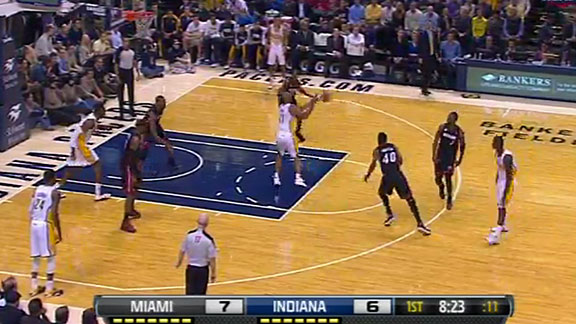
West is an enormously important player in every game, but he's especially important in this series because of this precise situation. He's by far the best among Indiana's bigs at catching and passing on the move, and if Indiana can time everything right, West will be able to hit corner shooters out of this action.
The "time everything right" caveat is, of course, nearly the entire story against Miami. This looks easy in a still photo, but it's incredibly hard in real life, where very fast human beings who can jump very high and have very long arms are running directly at you and (probably) making scary noises. Only Houston turned the ball over more often, per possession, than the Pacers, and Indiana looked borderline helpless against New York's pedestrian defense without Hill in Game 5 of the conference semifinals. Hill is only 6-foot-2 and Augustin, his backup, is a tiny person by NBA standards; short people have trouble against Miami's traps. Even if they can see and throw over arms belonging to, say, Bosh and Mario Chalmers, they are often moving backward while throwing those distressed passes, meaning they might end up tossing high-arcing softballs passes that give Miami plenty of time to reset its defense.
The Heat will deflect passes. They'll strip George, so turnover-prone while splitting defenders during pick-and-rolls that Frank Vogel temporarily banned him from even trying at one point this season. I'm scared to think what the Heat might do to Sam Young and Gerald Green, the only backup wings who have played any real postseason minutes for the Pacers, if either ever dares to actually dribble the ball. A radio host asked me this week if the Pacers even miss Granger, or if the Granger injury was a blessing in disguise. Um, yes, they miss him. I talked with Kevin Pritchard and Donnie Walsh in New York last week, and Granger's absence was one of the first things they mentioned. Even if he were available for only 15 minutes per game, as a backup for both Stephenson and George, he'd be enormously valuable in this series, simply because he is not Green or Young.
And it's unclear if the other Indiana bigs can even approximate West's passing in these situations. The Pacers cannot simply run pick-and-rolls with West in the middle of the floor over and over. Any good defense squashes that kind of predictability. The Pacers will have to run all sorts of pick-and-roll variations on the sides of the floor, including some that do not include West as the screener. The Heat will trap those side pick-and-rolls, which will leave guys like Hibbert and Tyler Hansbrough in situations like this:
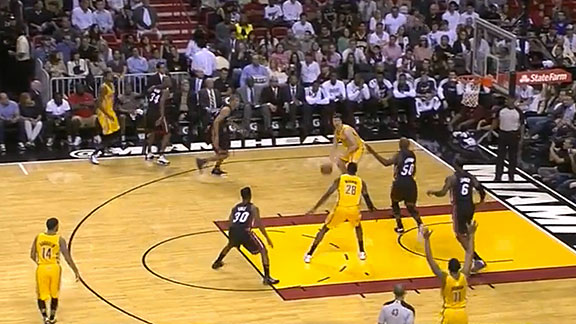
Hansbrough has just set a screen for George on the left sideline, rolled toward the hoop, and caught a pass from George. As you can see, both defenders involved in that pick-and-roll (Ray Allen and Shane Battier, Hansbrough's guy) trapped George, which is why they are behind Hansbrough here. That's fine. That is Miami's scheme, and they've sent a third defender (Joel Anthony, no. 50) over to Hansbrough's side of the floor to contain the action there.
This gives Hansbrough a precious second or two in which to pass to an open shooter somewhere on the perimeter. Problem: Hansbrough is a terrible passer. He and Ian Mahinmi, perhaps an even worse passer, have combined for 68 assists all season. Hibbert is a skilled post passer with nimble feet, but catching, dribbling, and dishing on the move is not really his game.
These are precisely the kinds of opportunities Indiana could not convert quite enough against Miami in last season's playoffs. The Pacers will have to be better, and Vogel has tried to find ways to make the task easier for them.
One such method is known around the NBA as "shorting" the pick-and-roll, a trick Mike D'Antoni's Phoenix team popularized. It looks like this, courtesy of the Clippers:
GHillshorting - YouTube
In very simple terms: One big man sets a screen and rolls down one side of the paint, while the other big pops up the other side, catches a quick pass, and (if all goes well) dishes to a shooter on the weak side a shooter who is (hopefully) open because his defender has sunk into the paint to contain that first rolling big. Indiana has tried this out, including against Miami, and if its bigs can manage a quick catch-and-pass against the league's fastest defense, there is long-range profit to be had.
But this kind of "if" is the biggest "if" in a series full of them.
2. Can the Pacers dominate the glass?
They did so on the surface during the regular season, when the Pacers rebounded a third of their own misses against Miami well above Denver's league-leading mark. But 22 of their 36 offensive boards against Miami came in one meeting in which the Heat just didn't look all that interested in dealing with Indiana's physicality. LeBron, for instance, just watched West parallel with James at the left elbow as George shoots walk in uncontested for this offensive rebound in that 22-rebound game on January 8:
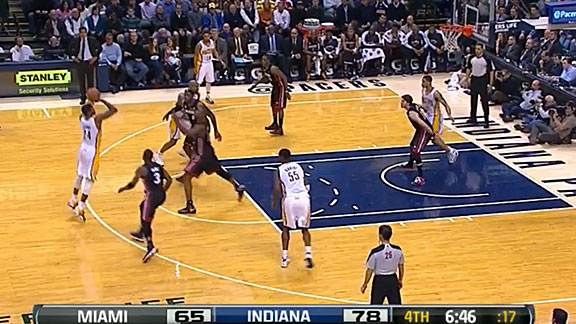
Miami cleaned this issue up in the final two meetings, and the Heat have a recent history of erasing their own blemishes when the games really start to count in the postseason; they cut their own turnover rate dramatically and clamped down on opposing 3-pointers in the playoffs last season, and they've been a totally different team on the defensive glass in these playoffs.3
Indiana has to win this battle, convincingly, in at least three or four games to have any chance in the series. It's just not good enough without the extra chances.
Hibbert is going to fall into some offensive rebounds simply because he is huge. Miami will have to fight hard to prevent the rest. West is a cutthroat brute who pushed around sometimes literally both Udonis Haslem and Battier under the basket.4 Each will have to do a bit better, especially Haslem, Miami's all-time leading rebounder. Bosh cannot afford one of his little blips of passivity against Hibbert.
Boxing out West and Hibbert is a challenge on its own. Boxing them out and leaping for a rebound is doubly hard, which is why Miami's perimeter players are going to have to recalibrate the balance between leaking out for fast breaks and helping out on the glass. The Heat will fare better on the boards if Bosh and Battier can focus on boxing out the Indiana bigs, knowing James or Wade or even Chalmers is ready to swoop in for a free rebound.
3. Can the Pacers cut down their turnovers?
The Pacers struggle with almost every aspect of ballhandling and passing dribbling against pressure, passing in tight spaces, and throwing entry passes over fronting defenses. All of this stuff is death against Miami, which couldn't muster its normal share of transition hoops against the Pacers in the regular season. If it does here, this series will be over, fast.
4. Can Indiana get the ball into the post, and then out of it?
Miami will try to front both Hibbert and West, and entering the ball to West with Battier on him is the path to the juiciest offensive stuff. The Pacers absolutely, positively cannot just have their offense stall out if Battier fronts West. They can't have George or Hill just stand there, contemplating a tricky lob pass as some help defender looms behind West and everyone else gawks. This is how you come up against the shot clock, take awful shots, and watch the Heat rain highlights on your head.
If the Pacers want West in the post, and Battier is fronting him, they either have to try the lob pass right away or (preferably) move immediately into something else. Indiana, thankfully, has gotten better at this since last season, when Battier's fronts flummoxed them.5 Indiana has cleared space for those lob entry passes early in the shot clock, before Miami's defense has gotten set, by running a simultaneous action on the other side of the floor that occupies any defender who might try to steal the lob pass near the rim. On this play, the decoy action is a double pin-down for George on the left side as Stephenson lofts the lob for West on the right block and with 16 seconds still on the shot clock:
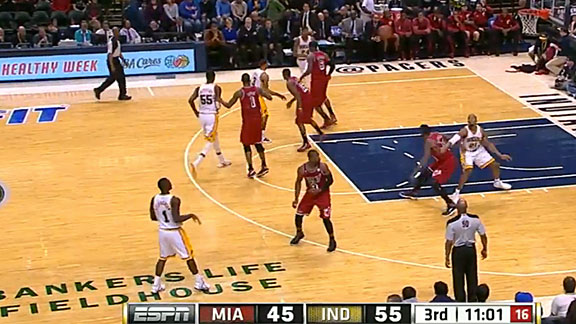
Another alternative when Battier is fronting West: just have the entry passer, usually Hill or George, dribble right at the Battier-West sandwich, using it as a monster screen. Hill/George can get to the rim this way if Battier doesn't help, and if he does, they can create a natural pick-and-pop with West or allow him to repost with Battier on his back.
Battier cannot guard West one-on-one if the Pacers can beat the front. West can overpower him for little jump hooks, and if he does so enough times, the Heat will have to swallow hard and send help they really don't want to send. At the very least, Miami's perimeter defenders will turn to watch the action in case they have to help, and the Pacers are experts at taking advantage of those turned heads with well-timed back screens:
IndybackscreenPG3 - YouTube
5. Will the Heat perimeter defenders pay attention?
Miami was a little sloppy in this regard in the regular season against various screening actions the Pacers like to run, both on and off the ball. It did a lot of switching, which led to both miscommunications and bad one-on-one matchups the Pacers could exploit. Wade can guard George in a pinch, but it's not an ideal matchup, especially considering Wade's knee issues. George can destroy any other non-LeBron Miami defender.
Here's one of many examples of a Miami perimeter player James pointing for a switch that doesn't happen in a timely fashion as the Pacers run his man (George) off a series of screens:
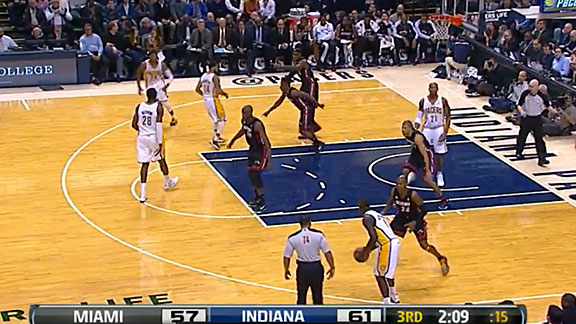
Wade's health looms over this question, and this entire series. He actually had a bit of trouble containing Stephenson off the dribble in one-on-one situations this season, and his sometimes lax off-ball defense helped spring Stephenson for 5-of-10 shooting from deep in three games. On the other end, Wade's post game has been a useful asset against Stephenson and whatever sad backup wing(s) the Pacers trot out. Which brings us to some smaller questions, centering on the Heat's offense against the Indiana defense.
6. Can Miami find the right balance between the post, the pick-and-roll, and its shot distribution?
High pick-and-rolls just won't cut it against Indiana, even if James is at the controls. The Pacers are too good, and any team depending on this simple play will find itself taking a lot of floaters and midrange shots over Hibbert and with Hill or George pestering them from behind.
The Heat have actually shown a preference for isolation plays and post-ups against Indiana, especially those plays, sort of a combination of each type, where the Heat clear one side of the floor for James to work on the block:
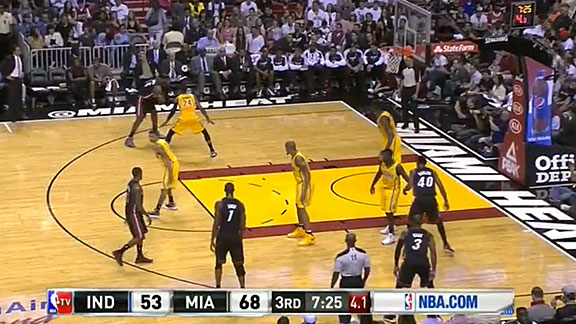
George has made a ton of progress as a post defender this season, and he held strong against Josh Smith and Carmelo Anthony in the playoffs. LeBron presents a different kind of test, mostly because of his passing skills, and the Heat have used these plays to draw help and generate open 3-pointers. Those 3s won't come as easily if George can handle LeBron with minimal help.
Indiana over three regular-season games limited Miami to just 15.7 3-point attempts per game about 6.5 fewer attempts than Miami's overall average.9 Indiana protected the 3-point line expertly all season; only Chicago allowed fewer opponent 3-point attempts, both overall and from the corners, and Indiana's opponents shot a league-low 32.6 percent on those shorter corner 3s, per NBA.com.
The Heat are going to have to work harder than usual to find open 3-pointers, using all the off-ball movement, misdirection, and high-flying pick-and-roll action in their very powerful arsenal. Bosh midrange jumpers are a workable substitute, especially since they take Hibbert far from the hoop, but Miami hits its untouchable gear when it's jacking 3s. The Wade-James pick-and-roll on the side of the floor got it some favorable switches and collapsed Indiana's defense, especially when Miami used two or three prior actions before flowing into that play. We haven't seen Miami's "A" offense yet in the playoffs. They will need it now.
7. Will either team cave?
Indiana has abandoned small ball completely, and Vogel is comfortable with his power forwards, West and Hansbrough, hiding out on Battier away from the ball. The Heat typically stay small, with James or Battier at power forward, after Battier replaces Haslem about halfway through the first and third quarters. But Erik Spoelstra deviated a bit in the regular season against Indiana and in the previous round against the always-big Bulls,10 playing Bosh and Chris Andersen together during what is normally small-ball time. This can be a useful tool during the few minutes James rests, because Miami's small-ball brilliance depends so much on James on both ends.
The Heat trade spacing for size and rebounding by going that route, though most of Miami's main small-ball units have held their own on the glass. If either team changes their dynamic at all in this series, it will be interesting to see which side wins out.
8. Can the Pacers squeeze anything from the bench and if so, from whom?
The Pacers' starting lineup is plus-80 in 236 postseason minutes. All other Indiana units are a combined minus-49 in 340 minutes, per NBA.com. Young will likely get spot minutes backing up George; Vogel trusts his defense, but the Heat won't guard Young on the other end, making it tough for Indiana to space the floor. Vogel clearly doesn't trust Green or Orlando Johnson, and neither has any shot defending James.
Translation: Indiana is toast if George gets in foul trouble. (The same is likely true of Hibbert, upping his minutes to never-before-seen territory in these playoffs.) It would not shock me if Vogel tried Stephenson on James during the precious few minutes George rests, especially if Young proves a catastrophe (again) on offense.
Augustin has been better in the postseason, hitting 17-of-43 from deep, but he'll struggle against Miami's pressure. The Hansbrough-Mahinmi duo remains as uneven as ever. The Pacers just need to tread water, and Vogel has done a nice job in the postseason extending minutes for his starters and making sure at least two or three of them are on the floor at all times. But this is always scary.
9. Will Spoelstra trip anyone by walking out on the court?
Probably not. But the threat is always there.
10. Can Battier stay fresh?
The Heat knew Battier could take some power forward minutes when they signed him, but neither he nor they expected he'd take on the assignment almost full time. He has proven up to it, though a trifecta of Carlos BoozerWestMarc Gasol/Tim Duncan/Tiago Splitter/Zach Randolph would test anyone, let alone a "wing" best known for defending Kobe Bryant. If Battier wears down, the Heat's core identity is endangered.
Prediction: Heat in five. They're just too good.
 Bron hasnt even played well, that's going to change. Battier and Ray aint really firing up from three, thats gonna change. And we only got 8 wins from a repeat. These other nikkas aint winning eight games before us
Bron hasnt even played well, that's going to change. Battier and Ray aint really firing up from three, thats gonna change. And we only got 8 wins from a repeat. These other nikkas aint winning eight games before us Get ready breh's, get ready.
Get ready breh's, get ready.
Breh's, we finna win this championship. Trust me, when I get these feelings, im never wrong. I got some Gypsy bloodBron hasnt even played well, that's going to change. Battier and Ray aint really firing up from three, thats gonna change. And we only got 8 wins from a repeat. These other nikkas aint winning eight games before us
Get ready breh's, get ready.

 slow your roll fella, dont jinx this.
slow your roll fella, dont jinx this.slow your roll fella, dont jinx this.




We're losing this game.
Jynx Gods, bless me!
